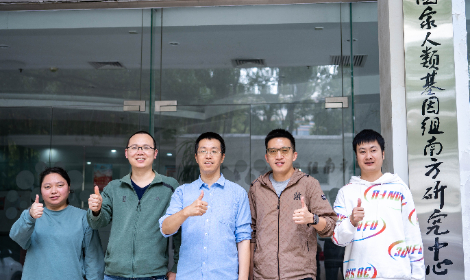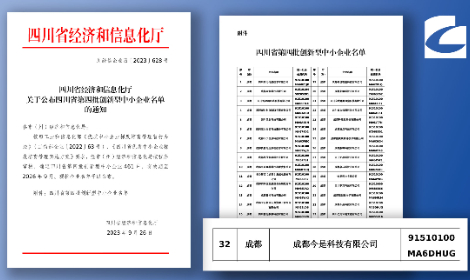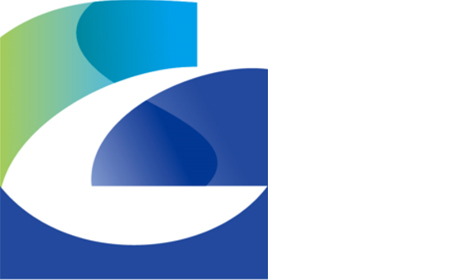
The researchers are experimenting
Gene sequencing development is going well
"If we understand our human genetic code as a book written in ciphertext, and to interpret its contents in a simple way, we need to use genetic sequencing. ''Development of the fourth generation of nanopore gene sequencer core microflow chip'' is our entrepreneurial project." The core component of the fourth-generation gene sequencer is a chip that integrates the microstream part that generates the sequencing signal and the measurement part that recognizes the signal, Su said. The purpose of the research and development of this project is to achieve the goal of "a few hundred yuan, a few drops of blood, and a few hours" of human whole gene sequencing, making it a routine testing means of precision medicine, and improving the health level of the whole people.
Su Yunpeng further explained that "several hundred yuan" is to reduce the price of human whole gene sequencing to several hundred yuan, so that every ordinary person can afford it. At present, the whole gene sequencing of a person needs to cost about 10,000 yuan, which is difficult for ordinary people to afford; "A few drops of blood" means that only a small sample, such as blood, body fluids or tissue, can be sequenced; "A few hours" means that the person receiving the gene sequencing can follow the test and wait for a few hours to obtain the sequencing report.
According to Su Yunpeng, the function of the gene sequencer is mainly: first, precise prevention. Through physical screening, know the probability of a person suffering from a disease in the future, so as to take appropriate preventive measures to minimize the probability of disease and delay the time of disease; Second, early screening. Early patients without obvious symptoms can be found and treated in time; The third is accurate diagnosis. Patients were classified by genetic background and molecular level, and personalized treatment methods were adopted to achieve "different treatment of the same disease" and "same treatment of different diseases" to improve treatment effect and reduce treatment cost. Fourth, accurate prognostic detection. Accurate monitoring of patients after receiving treatment not only reduces the probability of recurrence, but also avoids overtreatment.
Now that the project has made a major breakthrough, the team is working to integrate the system and develop an industrial prototype that is consistent with the basic architecture of the formal product. "There is no generation difference between the sequencer we developed and the world''s leading products in the UK and the US, and at the same time, it has its own advantages in cost and efficiency." Su Yunpeng said.
In terms of intellectual property rights, the company has built a technical route with independent intellectual property rights, broken through the technical barriers set by international competitors, and won the project support of the "2018 Sichuan Province Biotechnology and Medicine Major Science and Technology Special Project" to carry out the development of biological materials used in chips, chip flow and testing. At the same time, it has applied for 6 invention patents and PCT international patent priority, and has adopted strict intellectual property protection measures.
Former classmates started a business together
In the Spring Festival of 2016, Dr. Yaozhong Zou, Su Yunpeng''s middle school classmate who was doing research abroad at that time, told Su Yunpeng after returning to his hometown: "Although the current ''nanopore gene sequencing'' has been commercially realized in the United Kingdom, and it is close to commercial use in the United States, it is still in a blank state in China, we must catch up!"
However, this is a world-class difficult project, because the development of the project involves biochemistry, chips, materials science, micro-electro-mechanical systems (MEMS) and other fields, is a typical complex systems engineering. Although there is already a technical route with independent intellectual property rights, it is still necessary to form a strong R & D team to complete it. Perhaps by chance, several of Zou Yaozhong and Su Yunpeng''s middle school classmates are currently engaged in research projects that involve these topics.
Today, the company''s R & D team is strong, which makes the industry sit up and take notice: The founder, chairman and chief scientist, Dr. Yaozhong Zou, graduated from the Department of Biotechnology of Peking University in 1999, received his master''s degree in biochemistry from the Chinese Union Medical College in 2002, and received his PhD degree in biochemistry from the University of Illinois at Urbana-Champaign in 2008. He then entered the Kobilka Laboratory at Stanford University as a postdoctoral researcher and was a project participant in the 2012 Nobel Prize in Chemistry. He was engaged in the development and industrialization of related products in the United States.
The founder, director and CEO, Dr. Yunpeng Su, graduated from the Department of Materials Science and Engineering of Northwestern Polytechnical University. He studied at the State Key Laboratory of Solidification Technology of Northwestern Polytechnical University from 1999 to 2004 and obtained his PhD degree in Materials Science and Engineering. He worked as associate researcher, R&D manager, supply chain manager and operation manager in Hong Kong Polytechnic University, Chinalco Sapa Special Aluminum Co., LTD and Pratt & Whitney Company successively.
In addition, the founder, supervisor and IC director Jiang Ke graduated from Shanghai Jiao Tong University with a bachelor''s degree in information and control and a master''s degree in VLSI from Institute of Microelectronics, Tsinghua University. They have all become leaders in their fields of expertise.
So, with the ambition of serving the country, the heart of entrepreneurship of the five founders came together. After field visits to several cities, they believe that the investment policy of Chengdu High-tech Zone has strong attraction and comparative advantages, especially the biomedical industry chain of Chengdu High-tech Zone is relatively perfect, and the industrial foundation is relatively solid, so in October 2017, Chengdu Jinis Technology Co., Ltd. was registered in Chengdu High-tech Zone.
Commercial availability in 2022
On the entrepreneurial road, the company has obtained the full care of Chengdu High-tech Zone. For example, after the introduction of venture capital, the company obtained a financing subsidy of 1.5 million yuan from Chengdu High-tech Zone according to 10% of the financing amount; In the first two years of the company''s establishment, a total of no more than 800 square meters of rent subsidies can be reimbursed according to the facts; The company also enjoys tax advantages. At the same time, the Chengdu High-tech Zone has assessed Dr. Zou Yaozhong as a "Golden Panda talent", and has submitted the application materials for the selection of talents in Sichuan Province''s "Thousand Talents Plan" to the relevant departments.
Su Yunpeng deeply felt that for science and technology startups, in addition to the need for a steady stream of capital investment, but also need high-quality talents, the company has 5 doctors, 9 masters, other employees have undergraduate degrees. With the development of the company''s business, the company will also attract more professionals to join.
"Although the company has a registered capital of 10 million yuan, it still needs the help of the capital market in the long process of entrepreneurship." Su Yunpeng told reporters that the company received an angel round investment of 15 million yuan from Beijing Kai Venture Capital in 2017. At present, the company is implementing A series of financing. The company will enter the capital market when conditions are ripe. As for listing in the domestic capital market or in the overseas capital market, it needs to be decided according to the specific situation of the company at that time.
For gene sequencing market prospects, Su Yunpeng said that gene sequencing first entered the public''s vision in the 1990s. With the successful development of the Human Genome Project, scientists around the world spent about 15 years to interpret the template of the human genome. With the continuous upgrading of sequencing technology, according to the pharmaceutical giant Roche forecast that by 2025, the entire upstream and downstream market size of gene sequencing will exceed 600 billion US dollars.
The company plans to launch a 128-channel industrial prototype by the end of 2019; Launch the test version of the product for the scientific research market in 2020, collect the demand intention of the target customer group, and iterate the product accordingly to optimize the performance and function of the equipment; We will launch high-end products for the clinical market in 2022. "It is expected that the commercial product will achieve annual sales revenue of 1 billion yuan within three years after its launch, and it is expected to break the monopoly pattern of European and American manufacturers in the domestic market in the field of gene sequencing."
Su Yunpeng said that the company''s top priority is to focus on research and development! R&d! Re-develop! To catch up with and exceed the international advanced level in the field of gene sequencing. "Our goal is to let people ''hundreds of yuan, a few drops of blood, a few hours'' can carry out whole gene sequencing, so that it becomes a routine testing means of precision medicine, the company becomes a leader in the gene sequencing industry, and makes due contributions to improving the national health level!"

Geneus Technologies' first commercial nanopore gene sequencer G-seq500 is launched

Geneus Technology was successfully selected into the list of innovative smes in Sichuan Province

Chengdu Geneus Technology Co., Ltd. nanopore gene sequencing platform industrialization base environ..